As regenerative agriculture gains traction in the media and producers shift their focus toward sustainability, more ranchers are considering implementing rotational grazing systems. Traditionally, continuous grazing has been the default strategy for grazing cattle. Traditional grazing requires less fencing, maintenance and labor while providing acceptable animal weight gains – provided the stocking rate of the land is appropriate.
However, there are disadvantages to this system. The hands-off approach limits ranchers’ ability to control the timing and intensity of grazing. Therefore, during periods of slow growth, ranchers may need to adjust the number of animals in these pastures or find additional acreage to accommodate their nutritional needs.
Rotational grazing, on the other hand, provides ranchers the ability to control the timing and intensity of grazing. In these systems, ranchers divide the available grazing space into smaller paddocks and concentrate the number of grazing animals in a given paddock for shorter periods. Rotational grazing systems appeal to sustainability-minded ranchers but are also more expensive and labor-intensive. Moreover, outside factors including drought, forage type and stocking rate influence productivity regardless of the type of system. Grazing systems influence cattle weight gain and therefore ranchers’ bottom lines. It follows that the impact of each system is the center of the ongoing debate regarding the ideal grazing system.
Truthfully, the most profitable system is highly variable and unique to each operation. It is imperative that ranchers utilize all available research in order to strike a balance between pasture health and cattle weight gain. This decision is complicated by the need for more understanding of the relationship between rotational grazing and gains, with limited experimental evidence from extensive grazing operations to support either method decisively.
Fortunately, a recent study by a team at the USDA’s Agricultural Research Service (ARS) uses innovative technology to shed light on the practicality and profitability of each grazing system. The team utilized cattle GPS tracking collars to identify the link between different grazing systems and gains. As it turns out, the grazing system has a measurable impact on the foraging behavior of cattle. The results of the study, published this spring in Agriculture, Ecosystems & Environment, lay the foundation for a new understanding of the relationship between grazing management systems, foraging behaviors and cattle weight gain.
The technology was pioneered in a previous study that examined the relationship between behavior and long-term measures of gain. The first study, published in May 2022, utilized cattle GPS tracking collars to collect precise information about all aspects of foraging behavior, including grazing speed, length of meals and shape of paths throughout the pasture. The information provided by the tracking collars was determined to be a reliable indicator of foraging patterns and animal distribution, even in extensive rangelands.
The team of researchers then applied the same technology on a larger spatial scale to test the notion that rotational grazing management leads to decreased gains even on extensive rangelands. “It’s been shown many times that rotational grazing can lead to reduced weight gains of livestock. But most of those studies have been criticized by ranching communities because they’re done by scientists at small spatial scales, and they rotate the cattle on a fixed schedule, which is not really what ranchers do,” says David Augustine, an ARS research ecologist responsible for both studies. “So this was intended to be done at a larger spatial scale – more at the scale of a ranching operation.”
The study utilized two herds of steers with the animals either divided into smaller groups that followed a traditional, non-rotational grazing system or managed as part of a large herd in a multi-paddock rotational grazing system. The team utilized adaptive rotations for the second herd, responding to pasture and weather conditions to best mimic the actions of working ranchers. The team hypothesized that adaptive rotations would mitigate the decreased gains observed in past studies by moving cattle to new paddocks at optimal times rather than on a fixed schedule. Instead, they measured, on average, a 14% decrease in cattle weight gain for the rotationally grazed steers.
Thanks to the cattle GPS tracking collars, the researchers were able to observe trends in the foraging behaviors of both groups. They found that the steers in the rotational management system were limited in their freedom to roam and forage selectively. As a result, the steers in this system followed more linear paths to graze than the steers in the traditional management group. They grazed indiscriminately, eating whatever was available, whereas the traditionally managed steers followed more circular patterns to find and graze the most high-quality and protein-rich forage in the pasture. The decrease in average weight gain was attributed to the consumption of lower-quality forage by the rotationally managed cattle.
This result raises new questions about best management practices for rotational grazing systems. For one thing, the study suggests that the rotations themselves may not be the most important factor in a grazing system. Instead, it may benefit ranchers to pay close attention to stocking density and its influence on foraging behavior and selectivity. “One of the main goals of this experiment was to carefully control for stocking rates of both treatments at the same stocking rate over the five years,” says Augustine. “They just really differed in how the cattle were moved in space and time, and we're finding that that movement of cattle didn't have much benefit for the vegetation, but it did really alter forage behavior to reduce their weight gains.”
The published results cover the first five years of what will be a 10-year study comparing the two grazing systems. The team expects that the next five years will echo the same findings and provide additional clarity on the impact of other factors, such as weather, on cattle weight gain. The results so far provide a focus for future research: maintaining control over grazing while promoting foraging selectivity. “We’re looking forward to starting a new experiment where we’ll probably be grazing using larger pastures, to enable the animals to forage as selectively as they can while having some control over where and when they’re grazing,” says Augustine. In the meantime, the team hopes the study will help ranchers better understand foraging behavior and make informed decisions for their herds.










